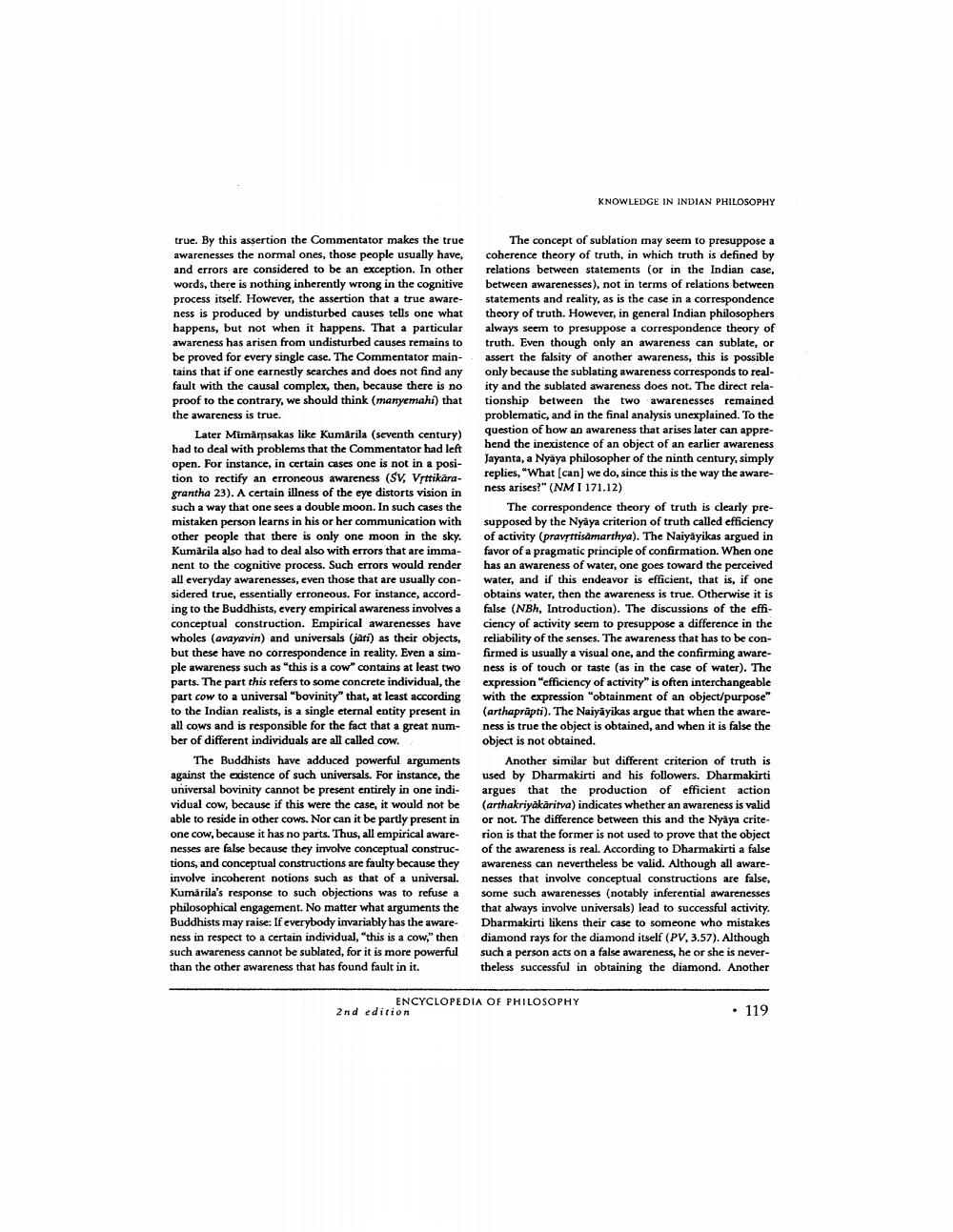Book Title: Knowledge In Indian Philosophy Author(s): Publisher: View full book textPage 5
________________ KNOWLEDGE IN INDIAN PHILOSOPHY true. By this assertion the Commentator makes the true The concept of sublation may seem to presuppose a awarenesses the normal ones, those people usually have, coherence theory of truth, in which truth is defined by and errors are considered to be an exception. In other relations between statements (or in the Indian case, words, there is nothing inherently wrong in the cognitive between awarenesses), not in terms of relations between process itself. However, the assertion that a true aware- statements and reality, as is the case in a correspondence ness is produced by undisturbed causes tells one what theory of truth. However, in general Indian philosophers happens, but not when it happens. That a particular always seem to presuppose a correspondence theory of awareness has arisen from undisturbed causes remains to truth. Even though only an awareness can sublate, or be proved for every single case. The Commentator main-. assert the falsity of another awareness, this is possible tains that if one earnestly searches and does not find any only because the sublating awareness corresponds to realfault with the causal complex, then, because there is no ity and the sublated awareness does not. The direct relaproof to the contrary, we should think (manyemahi) that tionship between the two awarenesses remained the awareness is true. problematic, and in the final analysis unexplained. To the Later Mimansakas like Kumarila (seventh century) question of how an awareness that arises later can apprehad to deal with problems that the Commentator had left hend the inexistence of an object of an earlier awareness open. For instance, in certain cases one is not in a posi Jayanta, a Nyaya philosopher of the ninth century, simply replies, "What (can) we do, since this is the way the awaretion to rectify an erroneous awareness (SV, Vstrikaragrantha 23). A certain illness of the eye distorts vision in ness arises?" (NM I 171.12) such a way that one sees a double moon. In such cases the The correspondence theory of truth is clearly premistaken person learns in his or her communication with supposed by the Nyaya criterion of truth called efficiency other people that there is only one moon in the sky. of activity (pravyttisamarthya). The Naiyayikas argued in Kumarila also had to deal also with errors that are imma favor of a pragmatic principle of confirmation. When one nent to the cognitive process. Such errors would render has an awareness of water, one goes toward the perceived all everyday awarenesses, even those that are usually con water, and if this endeavor is efficient, that is, if one sidered true, essentially erroneous. For instance, accord obtains water, then the awareness is true. Otherwise it is ing to the Buddhists, every empirical awareness involves a false (NBh, Introduction). The discussions of the efficonceptual construction. Empirical awarenesses have ciency of activity seem to presuppose a difference in the wholes (avayavin) and universals (jati) as their objects, reliability of the senses. The awareness that has to be conbut these have no correspondence in reality. Even a sim- firmed is usually a visual one, and the confirming awareple awareness such as "this is a cow contains at least two ness is of touch or taste (as in the case of water). The parts. The part this refers to some concrete individual, the expression efficiency of activity is often interchangeable part cow to a universal "bovinity" that, at least according with the expression "obtainment of an object/purpose to the Indian realists, is a single eternal entity present in (arthaprapti). The Naiyayikas argue that when the awareall cows and is responsible for the fact that a great num ness is true the object is obtained, and when it is false the ber of different individuals are all called cow. object is not obtained. The Buddhists have adduced powerful arguments Another similar but different criterion of truth is against the existence of such universals. For instance, the used by Dharmakirti and his followers. Dharmakirti universal bovinity cannot be present entirely in one indi argues that the production of efficient action vidual cow, because if this were the case, it would not be (arthakriyakaritva) indicates whether an awareness is valid able to reside in other cows. Nor can it be partly present in or not. The difference between this and the Nyaya criteone cow, because it has no parts. Thus, all empirical aware rion is that the former is not used to prove that the object nesses are false because they involve conceptual construc of the awareness is real. According to Dharmakirti a false tions, and conceptual constructions are faulty because they awareness can nevertheless be valid. Although all awareinvolve incoherent notions such as that of a universal. nesses that involve conceptual constructions are false, Kumarila's response to such objections was to refuse a some such awarenesses (notably inferential awarenesses philosophical engagement. No matter what arguments the that always involve universals) lead to successful activity. Buddhists may raise: If everybody invariably has the aware- Dharmakirti likens their case to someone who mistakes ness in respect to a certain individual, this is a cow," then diamond rays for the diamond itself (PV, 3.57). Although such awareness cannot be sublated, for it is more powerful such a person acts on a false awareness, he or she is neverthan the other awareness that has found fault in it. theless successful in obtaining the diamond. Another ENCYCLOPEDIA OF PHILOSOPHY 2nd edition * 119Page Navigation
1 ... 3 4 5 6 7 8 9
